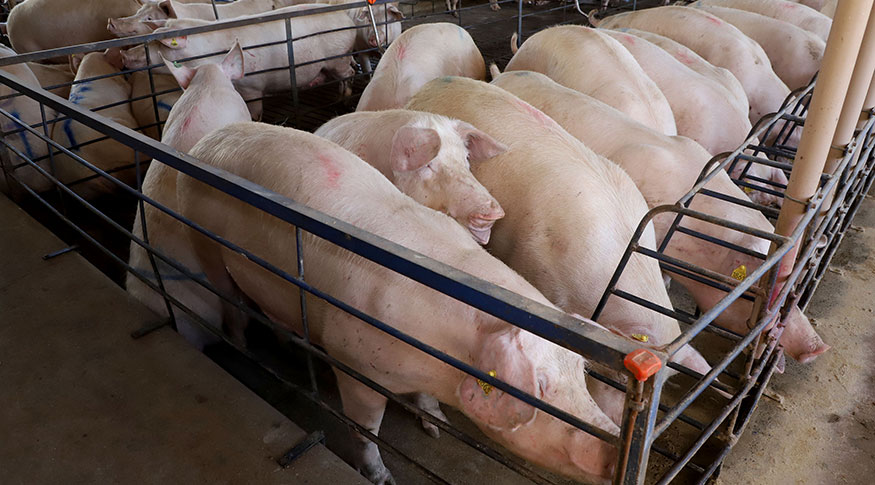Agricultural production
Slaughter of hogs and pigs in Q3 is record in time series
December 08, 2021 09h00 AM | Last Updated: December 08, 2021 02h59 PM

A total of 13.72 million hogs and pigs were slaughtered in the third quarter of 2021, a record figure in the time series that started in 1997. This figure represents an increase of 7.8% in relation to the same period in 2020 and an increase of 2.9% in comparison with the second quarter of 2021. These results are from Livestock Statistics, released today (8) by the IBGE.
The survey also shows that 1.54 billion chicken head were slaughtered. That figure means a rise of 1.2% over the third quarter of 2020 and of 0.7% in comparison with the second quarter of 2021, the best third quarter in the time series of the survey and the best performance ever registered in September.
Concerning cattle, 6.94 million head were slaughtered, the lowest level for a third quarter since 2004. That result represents a drop of 10.7% in relation to the third quarter of 2020 and of 2% over the second quarter of 2021.
According to Bernardo Viscardi, supervisor of the survey, the record result of exports of fresh pork, with the exports peak in September, helped the performance of the slaughter of hogs and pigs. The exports of hogs and pigs also benefit from the African swine fever that hit China, which continues to adopt measures to control the epidemic and restore the herd.
“Swines and chicken rose because they are more affordable than beef for the population that had their income reduced. Another highlight is the production of eggs, which exceeded the mark of 1 billion dozens in the quarter for the second time. As it is cheaper than meat, most of the population manage to demand more eggs,” says Viscardi.
Cattle slaughter kept the trend that started in 2020, with retention of heifers due to the high price of calves. Despite the retraction in the slaughter, the volume of fresh beef exported was the highest for a quarter, taking into account the time series of the Secretariat of Foreign Trade (SECEX/ME), with records for the months of August and September, 181.6 thousand tonnes and 187.0 thousand tonnes, respectively.
“The price of ox has been rising, due to the high slaughter of cows until 2019, which caused calves to lack. Now the producers are retaining more heifers to raise calves. Besides that retention, exports to China were restricted since September, which contributed to reduce the slaughter. The percentage of meat exported hit record levels above 30% of the total produced, in equivalence of carcasses. The foreign market was with a high share and these restrictions from China, which accounts for nearly 60% of the exports of the Brazilian meat, led many cold stores to reduce the slaughter. On the other hand, cold stores that address the local market were working with low margins or even negative ones, which also discouraged the slaughter,” says the supervisor of the survey.
Acquisition of raw milk amounted to 6.19 billion liters in the second quarter of 2021. That figure is equivalent to a drop of 4.9% in relation to the second quarter of 2020 and a rise of 6.1% in comparison with the immediately previous quarter. It should be highlighted that this sector has a cyclical behavior, in which third quarters usually show a recovery in relation to the previous quarter.
Viscardi notices that milk dropped in the annual comparison, reflecting the rise in the costs, especially with nutritional supplementation. While the sales of chicken, eggs and swines grow as they are more affordable, the population, when its income decreases, stops to consume milk derivatives like yogurt, cheese, cream cheese and butter.
“That discourages the production. As the producers cannot pass the costs on and get a fair price, which does not rise like the inputs, they manage to reduce the production. In addition, there were climate problems, like a very intense drought in the Central-West and part of the Southeast, as well as frosts in the South,” analyzes Viscardi.
The production of hen eggs hit 1.0 billion dozens in the third quarter of 2021, with a drop of 1.8% against the third quarter of 2020 and a rise of 1.5% against the second quarter of 2021. That result represents the second biggest output both for a third quarter and for the time series of the survey, started in 1987.
The Quarterly Survey of Leather Production showed that 7.37 million pieces of rawhide were received by tanneries, a drop of 10.4% against the third quarter of 2020 and of 2.2% in comparison with the second quarter of 2021. This scenario was influenced by the reduction in cattle slaughter, especially in September, when 2.06 million rawhide pieces were acquired, 23.5% below the same month a year ago.




















